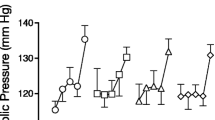Abstract
Cocaethylene (the ethyl ester of benzoylecgonine) is a product of the interaction between ethanol and cocaine. The results of preclinical studies and of a pilot clinical study have shown cocaethylene to produce pharmacologic effects similar to those of cocaine. However, no information is available concerning the potency and pharmacokinetics of cocaethylene in comparison to those of cocaine in humans. We report the results of a single-blind, crossover study in which six male, healthy, paid volunteers, who were moderate users of cocaine, were intravenously injected with the water soluble fumarate salt of cocaethylene (0.25 mg/kg cocaethylene base) or an equivalent dose of the water soluble hydrochloride salt of cocaine (0.25 mg/kg cocaine base). Each dose was dissolved in normal saline and injected over a 1-min interval. Test sessions were separated by a 1-week interval. The variables measured were: cocaine and cocaethylene plasma concentrations, subjective and cardiovascular effects. The results indicate, that in comparison to cocaine, cocaethylene had a significant smaller elimination rate constant (0.42 versus 0.67 l/h), had a longer elimination half-life (1.68 versus 1.07 h), and induced ratings of “high” and changes in heart rate that were of lower magnitude (65%, and 43%, respectively). During the period of time that pharmacologic effects were present the plasma concentrations of cocaine and cocaethylene were statistically indistinguishable. This finding supports the conclusion that in humans cocaethylene is less potent than cocaine.
Similar content being viewed by others
References
American College of Clinical Pharmacology (1982) Manual of symbols, equations and definitions in pharmacokinetics. Committee for Pharmacokinetic Nomenclature of the American College of Clinical Pharmacology, Philadelphia, Pa.
Bailey DN (1993) Serial plasma concentrations of cocaethylene, cocaine, and ethanol in trauma victims. J Anal Toxicol 17:79–83
Farre M, De la Torre M, Lamas X, Ugena B, Segura J, Cami J (1993). Alcohol and cocaine interactions in humans. J Pharmacol Exp Ther 266:1364–1373
Foltin RW, Fischman MW (1989) Ethanol and cocaine interactions in humans: cardiovascular consequences. Pharmacol Biochem Behav 31:877–883
Hearn WL, Flynn DD, Hime GW, Rose S, Cofino JC, Mantero-Atienza E, Wetli CV, Mash DC (1991a) Cocaethylene: a unique cocaine metabolite displays high affinity for the dopamine transporter. J Neurochem 56:698–701
Hearn WL, Rose S, Wagner J, Ciarlegio A, Mash DC (1991b) Cocaethylene is more potent than cocaine in mediating lethality. Pharmacol Biochem Behav 39:531–533
Higgins ST, Rush CR, Bickel WK, Hughes JR, Lynn M, Capeless MA (1993) Acute behavioral and cardiac effects of cocaine and alcohol combinations in humans. Psychopharmacology 111:285–294
Jacob P, Mendelson JE, Jones RT, Benowitz NL (1993) Formation and elimination kinetics of cocaethylene in humans. Clin Pharmacol Ther 53:174
Jatlow P (1993) Cocaethylene: pharmacologic activity and clinical significance. Ther Drug Monit 15:533–536
Jatlow P, Elsworth JD, Bradberry CW, Winger G, Taylor JR, Russell R, Roth RH (1991) Cocaethylene: a neuropharmacologically active metabolite associated with concurrent cocaineethanol ingestion. Life Sci 48:1787–1794
McCance-Katz EF, Price LH, McDogle CJ, Kosten TR, Black JE, Jatlow PI (1993) Concurrent cocaine-ethanol ingestion in humans: pharmacology, physiology, behavior, and the role of cocaethylene. Psychopharmacology 111:39–46
Metzer CM, Weiner DL (1992) PCNONLIN, 4th edn. SCI Software, Lexington, Ky.
Murphy JM, Gatto GJ, Dean RA, Bosron WF (1991) Intracranial self-administration (ICSA) of ethylcocaine (EC), an active metabolite of ethanol and cocaine. Alcohol Clin Exp Res 15:314
Perez-Reyes M (1993) Subjective and cardiovascular effects of cocaethylene in humans. Psychopharmacology 113:144–147
Perez-Reyes M, Jeffcoat AR (1992) Ethanol/cocaine interaction: cocaine and cocaethylene plasma concentrations and their relationship to subjective and cardiovascular effects. Life Sci 51:553–563
Randall T (1992) Cocaine, alcohol mix in body to form even longer lasting, more lethal drug. JAMA 267:1043–1044
Sherwood A, Allen, MT, Fahrenberg J, Kelsey RM, Lovallo WR, Van Doornen LJP (1990) Methodological guidelines for impedance cardiography. Psychophysiology 27:1–23
Woodward JJ, Mansbach R, Carroll FI, Balster RL (1991) Cocaethylene inhibits dopamine uptake and produces cocainelike actions in drug discrimination studies. Eur J Pharmacol 197:235–236
Author information
Authors and Affiliations
Rights and permissions
About this article
Cite this article
Perez-Reyes, M., Jeffcoat, A.R., Myers, M. et al. Comparison in humans of the potency and pharmacokinetics of intravenously injected cocaethylene and cocaine. Psychopharmacology 116, 428–432 (1994). https://doi.org/10.1007/BF02247473
Received:
Revised:
Issue Date:
DOI: https://doi.org/10.1007/BF02247473




